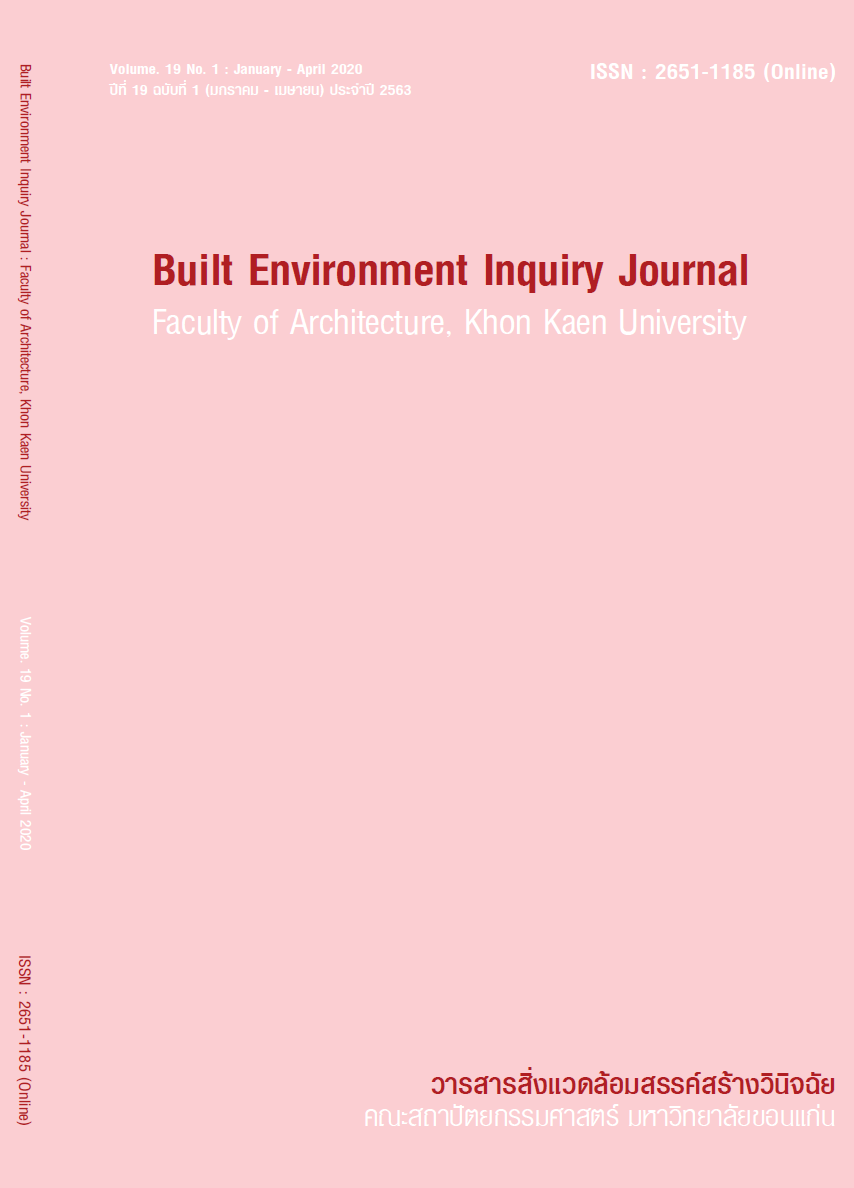การพัฒนาโปรแกรมเสริมบนแบบจำลองสารสนเทศอาคาร เพื่อช่วยในการประเมินประสิทธิภาพการใช้พื้นที่อาคารเรียนในมหาวิทยาลัย
คำสำคัญ:
ประสิทธิภาพการใช้ประโยชน์อาคาร, ประสิทธิภาพการใช้ห้องเรียน, แบบจำลองสารสนเทศอาคารบทคัดย่อ
มหาวิทยาลัยได้กำหนดแนวทางการพัฒนาในด้านการบูรณาการ การพัฒนาและบริหารจัดการสิ่งแวดล้อมกายภาพ อาคารสิ่งก่อสร้าง และพื้นที่ต่างๆ เพื่อส่งเสริมการเรียนรู้ ตามประกาศกระทรวงศึกษาธิการนั้นได้กำหนดให้สถาบันอุดมศึกษาทำการประเมินประสิทธิภาพการใช้ประโยชน์อาคาร พร้อมทั้งจัดทำรายงานส่ง อย่างไรก็ตามปริมาณข้อมูลที่นำมาใช้ในการวิเคราะห์นั้นมีจำนวนมากและข้อมูลมีความซับซ้อน ซึ่งขาดการเชื่อมโยงข้อมูลทั้งหมดระหว่างหน่วยงาน รวมถึงใช้ระยะเวลาในการประเมินมาก ในการวิจัยนี้จึงได้พัฒนาเครื่องมือที่ช่วยในการประเมินประสิทธิภาพการใช้ประโยชน์อาคารร่วมกับการใช้แบบจำลองสารสนเทศอาคาร โดยมีขั้นตอนในการใช้งานแบ่งเป็น 4 ส่วนหลักคือ ส่วนที่ 1 การเตรียมระบบข้อมูลสำหรับเป็นฐานข้อมูลและการแสดงผล และการเตรียมแบบจำลองสารสนเทศอาคารส่วนที่ 2 การตั้งค่าฐานข้อมูลและกระบวนการเชื่อมโยงข้อมูล ส่วนที่ 3 การวิเคราะห์ประสิทธิภาพการใช้ประโยชน์อาคาร และการแสดงผลในแบบแปลนและในรูปแบบรายงาน ทั้งในระดับอาคารและระดับคณะ/สำนัก ส่วนที่ 4 เสนอแนะแนวทางการเพิ่มประสิทธิภาพการใช้ประโยชน์อาคาร ในรูปแบบรายงาน จากการใช้งานเครื่องมือที่ได้พัฒนาสำหรับแต่ละอาคาร ใช้เวลาแต่ละขั้นตอนประมาณ 5 นาที ซึ่งทำให้ได้ผลลัพธ์ 4 อย่าง ได้แก่ 1) การแสดงผลการประเมินตามค่าระดับสีในแบบแปลนบนแบบจำลองสารสนเทศอาคาร 2) รายงานผลการประเมินประสิทธิภาพการใช้ประโยชน์อาคารในระดับอาคาร 3) รายงานผลการประเมินประสิทธิภาพการใช้ประโยชน์อาคารในระดับคณะ/สำนัก 4) รายงานแนวทางการเพิ่มประสิทธิภาพการใช้ประโยชน์อาคาร โดยในส่วนโปรแกรมที่ได้พัฒนานี้จะทำหน้าที่เชื่อมโยงระหว่างแบบจำลองสารสนเทศอาคารและฐานข้อมูล ซึ่งจะช่วยลดกระบวนการทำงานที่ซ้ำซ้อน และช่วยเพิ่มประสิทธิภาพการใช้งานข้อมูลในแบบจำลองสารสนเทศอาคาร รวมถึงช่วยลดระยะเวลาในการประเมินผล
เอกสารอ้างอิง
Akanmu, A., Olatunji, O., Love, P.E.D., Matthews, D.N., & Matthews, J. (2016). Auto-generated site layout: An integrated approach to real-time sensing of temporary facilities in infrastructure projects. Structure and Infrastructure Engineering,12, 1243-1255.
Ake-rarerngsaen, N. (2017). Analyzing fire evacuation paths with Building Information Modeling technology (Unpublished master’s thesis). Retrieved from http://digital.library.tu.ac.th/tu_dc/frontend/Search/index/
Arayici, Y., Fernando, T., Munoz, V., & Bassanino, M. (2018). Interoperability specification development for integrated BIM use in performance-based design. Automation in Construction, 85, 167-181.
Architect Council of Thailand, Council of Engineers, & The Engineering Institute of Thailand. (2017). Building information modeling guide. Bangkok: EIT.
Charoensuttiyotin, A. (2018). Development of Building Information Modeling (BIM) to calculate the verall Thermal Transfer Value (OTTV) in schematic design stage (Unpublished master’s thesis). Retrieved from https://cuir.car.chula.ac.th/
Chief Transformation and Strategic office. (n.d.). phǣn yutthasāt Čhulālongkō̜nmahāwitthayālai 2560-2563. (in Thai) [Strategic plan of Chulalongkorn University 2017-2020]. Retrieved April 22, 2019, Retrieved from http://www.osm.chula.ac.th/
Ciribini, A. L.C., Pasini, D., Tagliabue, L.C., Manfren, M., Daniotti, B., Rinaldi, S., & Angelis, E.D. (2017). Tracking users’ behaviors through real-time information in BIMs: Workflow for interconnection in Brescia Smart Campus Demonstrator. Procedia Engineering, 180, 1484-1494.
Khosakitchalert, C., (2013). Verification on applicability of American Institute of Architect’s level of detail guideline for Building Information Modeling to architectural quantity takeoff methods in Thai construction industry (Unpublished master’s thesis). Retrieved from https://cuir.car.chula.ac.th/
Khumpairoj, T. (2018). BIM-Base tool for building life cycle greenhouse gas emissions assessment in early design stage: Case study residential building (Unpublished master’s thesis). Retrieved from https://cuir.car.chula.ac.th/
Kumar, S.S. and Cheng, J.C.P. (2015). A BIM-based automated site layout planning framework for congested construction sites. Automation in Construction, 59, 24-37.
McArthur, J.J. (2015). A Building Information Management (BIM) framework and supporting case study for existing building operations, maintenance and sustainability. Prodedia Engineering, 118, 1104-1111.
Nakabutara, P. (2010). The assessment of building usage: The faculty of architecture’s building, Silpakorn University (Unpublished master’s thesis). Retrieved from http://www.thapra.lib.su.ac.th/thesis/
Nical, A.K., Wodynski, W. (2016). Enhancing facility management through BIM 6D. Prodedia Engineering, 164, 299-306.
Office of Physical Resources Management, Chulalongkorn University. (n.d.). nænam samnak kāiyaphāp.(in Thai) [Introducing the physical office]. Retrieved from http://www.prm.chula.ac.th/
Prakāsok ra sūang sưksāthikān rư̄ang nǣothāng kān phœ̄m prasitthiphāp kānchai prayōt ʻākhān khō̜ng sathāban ʻudomsưksā. (in Thai) [Announcement Ministry of Education in guideline of increasing the efficiency of building utilization for higher education institutions]. (2013, April 11). Thai Government Gazette. 130 (Pt. 47ng), 19-21.
Prasoptin, C., & Phitthayayon, A. (2015). Space utilization in the faculty of environment and resource studies, Mahidol University for academic year 2012. Journal of Professional Routine to Research, 2, 63-80.
Sthapitanonda, L., Srihiran, K., Chotipanich, S., & Chukiatman, K. (2001). kān phœ̄m prasitthiphāp kānchai phư̄nthīʻākhān rīan nai Čhulālongkō̜nmahāwitthayālai. (in Thai) [Optimization of building utilization efficiency in Chulalongkorn University] (Unpublished manuscript). Bangkok: Department of Architecture, Chulalongkorn University.
Sthapitanonda, P. (2010). rabīap withī wičhai kānsư̄sān [Research methodology in communication] (6th ed.). Bangkok: Chulalongkorn University Press.
The Association of Siamese Architects under royal patronage. (2015). Thailand BIM Guideline (1st ed.). Bangkok: Plus Press.
Watthanakit, P. (1999). rabīap withī wičhai: wičhai sangkhommasāt. (in Thai) [Research methodology: Research in social sciences and humanities]. Bangkok: n.p.
ดาวน์โหลด
เผยแพร่แล้ว
รูปแบบการอ้างอิง
ฉบับ
ประเภทบทความ
สัญญาอนุญาต
ทัศนะและข้อคิดเห็นของบทความที่ปรากฏในวารสารฉบับนี้เป็นของผู้เขียนแต่ละท่าน ไม่ถือว่าเป็นทัศนะและความรับผิดชอบของกองบรรณาธิการ




